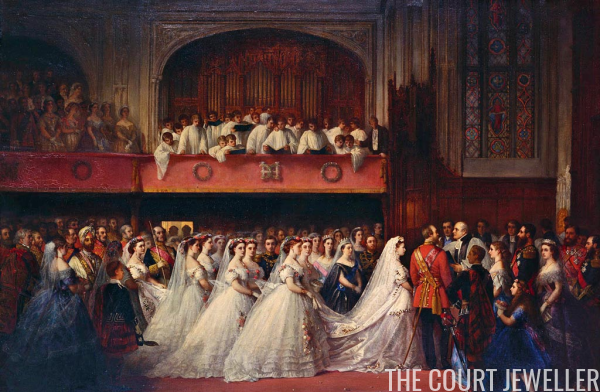 |
| Christian Karl Magnussen’s “The Marriage of Princess Helena” (1866-9); see a much larger image at the Royal Collection website |
On the afternoon of July 5, the marriage of the Princess Helena Augusta Victoria [1], third daughter of Her Majesty [2], with His Royal Highness Prince Christian of Schleswig-Holstein-Sonderburg-Augustenburg [3], was celebrated in the chapel within Windsor Castle.
The wedding was a private one, and consequently, much of the ceremonial which attends state marriages was dispensed with; but, apart from the position of the personages most immediately interested, the presence of the Queen, of the King and Queen of the Belgians [4], of the Prince and Princess of Wales [5], the Duke of Edinburgh [6], and other members of the royal family, of the ambassadors of foreign powers, the heads of the retiring and the incoming governments, and some of the most distinguished members of the aristocracy, rendered it a ceremony of public interest and public importance.
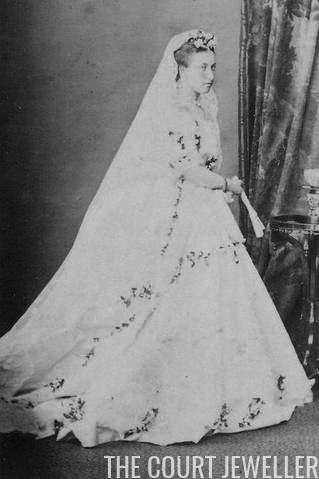 |
| Princess Helena in her wedding gown (Photo: Grand Ladies Site) |
The Queen, in person gave away the bride, responding to the inquiry made by the Primate with a gesture full of dignity and determination. The whole of the service was performed by the Archbishop of Canterbury [7]. The responses of both the bride and bridegroom were made in a firm and audible voice. The bridegroom spoke with a decidedly foreign accent, and in the long declaration which accompanies the plighting of the troth appeared to have some little difficulty in completely following the archbishop, and in enunciating all the words which he was called upon to pronounce; but there was no doubt about the “I will” with which he answered the question whether he would have the princess to be his wedded wife.
The assent of the bride was almost equally decidedly pronounced; and if in the longer passage which precedes the troth-plight her voice sometimes wavered, it never ceased to be audible, and, though low and gentle, was generally clear and distinct.
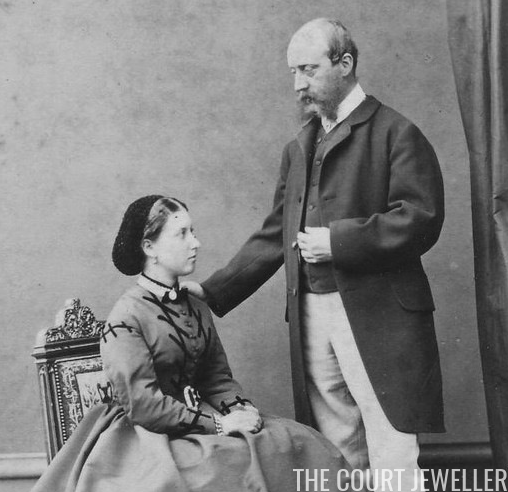 |
| Prince Christian and Princess Helena (Photo: Grand Ladies Site) |
The ceremony over, the bride was warmly embraced by Her Majesty and the Prince of Wales; and, leaning upon the arm of her husband, Her Royal Highness was then conducted to the white drawing room, the royal procession accompanying and attending them, and in presence of the dignitaries of the Church, the registry of the marriage was attested in due form.
At a quarter past four o’clock, Their Royal Highnesses Prince and Princess Christian of Schleswig-Holstein left by special train for Southampton, en route for Osborne, receiving at their departure fresh proof of the affectionate interest felt in their happiness by Her Majesty.
The Queen wore a black moire antique dress, interwoven with silver, and trimmed with black crepe and a row of diamonds round the body. She also wore a coronet of diamonds — attached to a long white crepe lisse veil, a diamond necklace and cross, and a brooch composed of a large sapphire set in diamonds [8]. And over all, the ribbon and star of the Order of the Garter and the Victoria and Albert conspicuously shone.
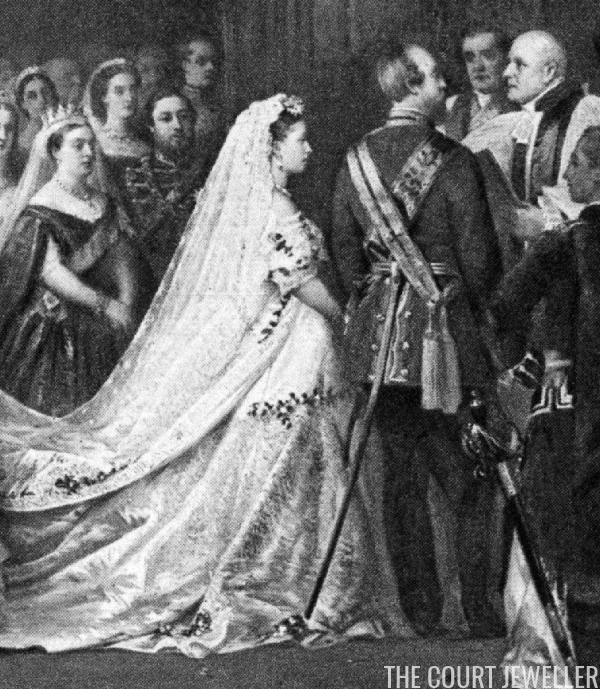 |
| Black-and-white detail of the Magnussen wedding portrait (Image: Grand Ladies Site) |
Her Royal Highness Princess Helena was attired in a bridal dress of rich white satin with deep flounces of Honiton guipure, the train of extra length, trimmed with bouquets of orange blossom and myrtle; the design of the lace being of roses, ivy, and myrtle. Her wreath was composed of orange blossoms and myrtle; and the bridal veil, a square, was of the choicest Honiton lace, to match the dress. Her Royal Highness also wore a necklace, earrings, and brooch, with the Order of Victoria and Albert.
The Princess of Wales wore a dress of blue tulle over blue silk, richly trimmed with Irish lace, ribbons, and lilies of the valley. Her head-dress was a tiara of diamonds and veil; ornaments, pearls and diamonds. She, too, wore the Victoria and Albert order, and the Order of Catherine of Russia. Her royal husband was in the uniform of a colonel of the Hussars, and wore the insignia of the Garter.
The Princess Louise wore a white glace petticoat covered with tulle illusion trimmed with Brussels point lace under a body, and pointed tunic of blue satin trimmed with point lace and blue and frosted silver ornaments. Coiffure, a wreath of blush roses and silver, tulle veil. The dress of Princess Beatrice consisted of a blue satin dress trimmed with point lace and blue and frosted silver ornaments. Coiffure, a wreath of blush roses and silver, tulle veil.
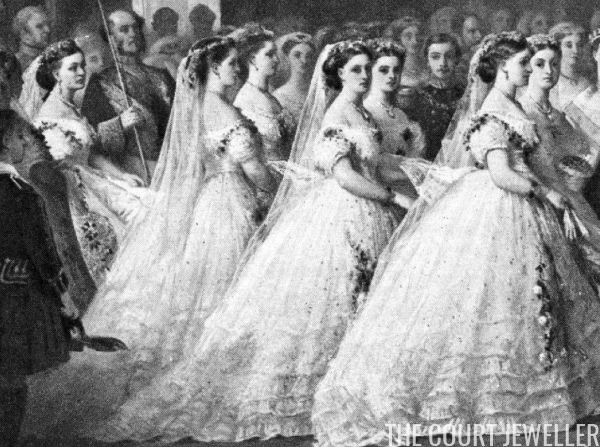 |
| Black-and-white detail of the Magnussen wedding portrait (Image: Grand Ladies Site) |
The ladies acting as bridesmaids were dressed in a white glace dress covered with plaitings bouillonee of tulle under a long tunic of silver tulle, which was looped up on one side with a chatelaine of pink roses, forget-me-nots, and white heather; the body and skirts were also trimmed with branches of pink roses, forget-me-nots, and heather, with long tulle veil.
The Princess Helena’s traveling dress consisted of a white glace slip under a dress of fine white Swiss muslin trimmed with Valenciennes lace, bonnet of white tulle trimmed with orange blossom, and a large mantle of white China crepe lined with white silk and trimmed with fancy chenille and silk fringe and ornaments.
The dresses of the guests were — for ladies, full dress without trains; for gentlemen, full dress with trousers, the knights of the several orders wearing their respective collars.
The Princess Helena of England and her husband, Prince Christian, left Paris on July 24 for Lyons.
NOTES
1. Princess Helena of the United Kingdom (1846-1923), fifth child and third daughter of Queen Victoria and Prince Albert. She was known as Princess Christian of Schleswig-Holstein after her marriage (that is, until George V removed the family’s German titles in 1917, after which she was simply known as “Princess Christian”). Helena and Christian had four children who lived to adulthood: Prince Christian Victor, Prince Albert, Princess Helena Victoria, and Princess Marie Louise.
2. Queen Victoria of the United Kingdom (1819-1901), mother of the bride. This wedding took place not quite five years after Prince Albert’s death; Victoria was 47.
3. Prince Christian of Schleswig-Holstein (1831-1917), son of Christian August II, Duke of Schleswig-Holstein. Christian’s marriage to Helena was initially controversial. This was partly because he was fifteen years older than she was. Even more problematic, though, was the issue of his homeland: two wars had recently been fought between Denmark and Prussia over control of Schleswig-Holstein. Helena’s eldest sister, Vicky, was married to the Crown Prince of Prussia; likewise, Helena’s sister-in-law, the Princess of Wales, was the daughter of the King of Denmark. Helena, however, was genuinely in love with Christian, and the marriage went ahead, even though it caused much tension in the family.
4. King Leopold II (1835-1909) and Queen Marie Henriette (1836-1902) of Belgium. Leopold was Queen Victoria’s first cousin; he had only ascended to the throne of Belgium about eight months before this wedding.
5. King Edward VII (1841-1910) and Queen Alexandra (1844-1925) of the United Kingdom, then the Prince and Princess of Wales, were the brother and sister-in-law of the bride.
6. Prince Alfred, Duke of Edinburgh (1844-1900), later Duke of Saxe-Coburg and Gotha, was an elder brother of the bride.
7. Charles Thomas Longley (1794-1868) served as Archbishop of Canterbury from 1862 until his death in 1868.
8. This is the Albert Brooch, the sapphire and diamond brooch given to Queen Victoria by Prince Albert just before their wedding. She wore it pinned to her gown during their wedding ceremony. Today, it is owned and worn by Queen Elizabeth II.
Leave a Reply